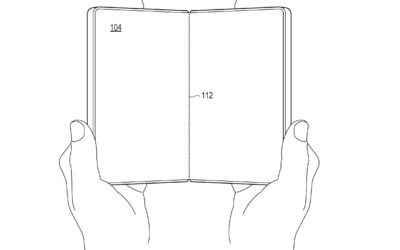Microsoft is reportedly exploring a new direction in the foldable device market after discontinuing its Surface Duo line of Android-powered smartphones. A recently uncovered patent application suggests the tech giant is developing a new foldable device concept.

The patent application, filed with the United States Patent and Trademark Office on February 29, details a unique approach to foldable phone design featuring a "spine cover plate." This technology aims to improve durability and minimize the visible crease typically found in foldable displays.
The patent suggests a book-style design, similar to the Samsung Galaxy Z Fold. The core innovation lies in the "spine cover plate," a mechanism designed to protect the device's single-hinge system.
The key difference between traditional hinges and Microsoft's design is the spine cover's automatic adjustment during opening and closing. This is intended to eliminate gaps around the hinge, protecting it from dust and water. Currently, Samsung's foldable devices offer an IPX8 rating, providing only water resistance.
Microsoft's patent emphasizes minimizing the hinge crease, a common concern among foldable smartphone users. The new hinge mechanism is designed to make the crease less noticeable compared to existing foldable devices.
Furthermore, the design incorporates techniques to reduce the overall thickness of the foldable smartphone. The spine cover plate can move closer to the device's hinge when folded, resulting in a slimmer profile.
Microsoft explains in the patent that retracting the spine cover plate toward the central spine as the display-supporting frames rotate allows for a reduced width when folded. This aims to make the device easier and more comfortable to handle, especially with one hand.
The market is continuously seeking ways to eliminate the foldable crease. While some manufacturers have implemented water-drop folding mechanisms to mitigate it, a truly crease-free foldable is yet to be seen. Moreover, the durability of these devices is paramount, considering the presence of numerous moving parts.
The addition of a movable part on top of the existing foldable mechanism raises questions about practicality. Despite the potential benefits and enhanced durability outlined in the patent application, the complexity of the design could introduce new challenges. Whether Microsoft's innovative approach will translate into a successful and reliable foldable device remains to be seen.
Newer articles
Older articles
 India Enters New Space Age as Astronaut Shukla Joins ISS Mission
India Enters New Space Age as Astronaut Shukla Joins ISS Mission
 X Cracks Down: Half a Million Indian Accounts Suspended for Policy Breaches
X Cracks Down: Half a Million Indian Accounts Suspended for Policy Breaches
 Google Unveils Strategy to Combat Misinformation, Boost Voter Access in India's 2024 Elections
Google Unveils Strategy to Combat Misinformation, Boost Voter Access in India's 2024 Elections
 Hair Oil vs. Hair Serum: Which is the Right Choice for Your Hair?
Alternatively:
Unlock Your Best Hair: Choosing Between Hair Oil and Serum for a Healthy Mane
Hair Oil vs. Hair Serum: Which is the Right Choice for Your Hair?
Alternatively:
Unlock Your Best Hair: Choosing Between Hair Oil and Serum for a Healthy Mane
 Bollywood's 'Swades' Anthem Joins Axiom-4 Mission: Indian Astronaut's Playlist Honors Heritage in Space
Bollywood's 'Swades' Anthem Joins Axiom-4 Mission: Indian Astronaut's Playlist Honors Heritage in Space
 Vijay Sethupathi Apologizes Amid Controversy Over Son's Film 'Phoenix'
Vijay Sethupathi Apologizes Amid Controversy Over Son's Film 'Phoenix'
 New York Assemblyman Zohran Mamdani's Style: 5 Lessons in Authenticity and Heritage
New York Assemblyman Zohran Mamdani's Style: 5 Lessons in Authenticity and Heritage
 Colon Cancer: Don't Ignore These 5 Early Warning Signs
Colon Cancer: Don't Ignore These 5 Early Warning Signs
 TSMC Regains Top 10 Global Value Ranking Amid AI Boom
TSMC Regains Top 10 Global Value Ranking Amid AI Boom
 Android Users Urged to Update Devices Amid High-Severity Security Flaws: Government Issues Warning
Android Users Urged to Update Devices Amid High-Severity Security Flaws: Government Issues Warning